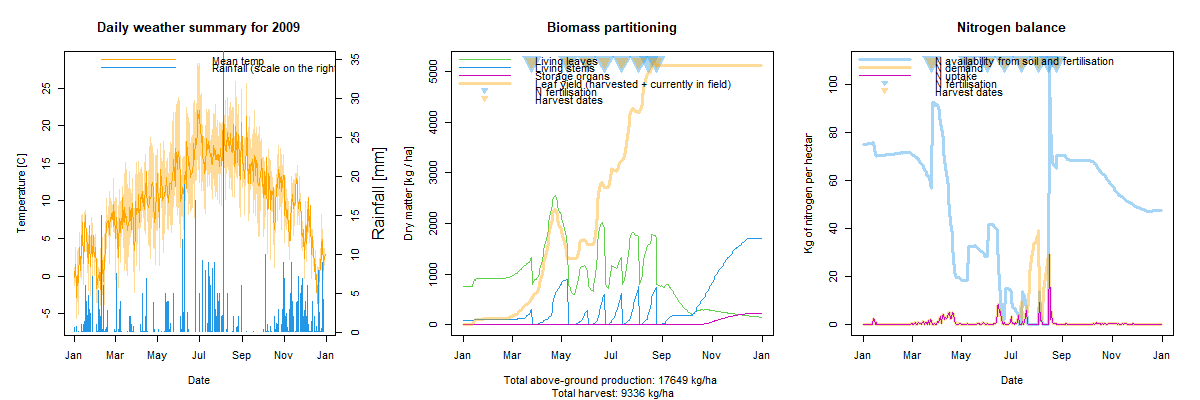LingraNR, tutorial
R Interface to LINGRA-N Tool, grassland productivity model and functions to implement the grassland productivity metamodel of Qi at al. (2017 & 2018)1,2.
Installation
devtools::install_github('lucabutikofer/LingraNR')
Documentation
LINGRA-N is a grass growth model which can calculate grass growth and yields under potential, water-limited and nitrogen-limited growing conditions. LINGRA-N is a generic model which can be used for different grass types growing under a large range of soil and weather conditions and with different mowing regimes. The background document and detailed information about LINGRA-N and its FORTRAN code are provided by Wolf (2012)3.
Under the NERC Research Translation: Grassland Management project (NE/R017387/1), supported by the Sustainable Agriculture Research and Innovation Club (SARIC), the original LINGRA-N model was further developed and released as a Microsoft Excel workbook (the LINGRA-N Tool) for use as an adaptive learning tool by students, grassland managers and advisors. A key difference between LINGRA-N Tool and its predecessor is a vastly improved nitrogen balance routine, which motivated the creation of this package.
Package LingraNR is an R wrapper for the LINGRA-N Tool, allowing the model to be ran entirely without leaving the R environment. LINGRA-N computations are carried out internally to the Excel Workbook via the xlsx R package (Java based), while LingraNR manages inputs and outputs, and provides functions to display the model’s results.
Additionally, functions to run the grassland productivity metamodel of Qi et al. (2017 & 2018)1,2 for the UK are also provided.
Running LINGRA-N
LINGRA-N simulations are carried out by function Lingranr(). This requires information on weather, soil, and management.
Weather
Weather data is to be provided in daily time steps and must contain information on:
- Total solar radiation [MJ/m2*day]
- Minimum daily tempterature [°C]
- Maximum daily tempterature [°C]
- Vapour pressure [kPa]
- Mean daily wind speed [m/s]
- Total daily rainfall [mm]
Additionally, date and location information are added to the weather input table. See ?Lingranr for details and weatherExmpl for and example.
Soil
Soil information is to be provided for each location and must contain:
- Soil depth [mm]
- Moisture content at field capacity [mm3/mm3]
- Moisture content at saturation [mm3/mm3]
- Moisture content at wilting point [mm3/mm3]
See ?Lingranr for details and soilExmpl for and example.
Management
Management information is to be provided as two separate objects specifying harvest dates and fetilisation dates with fertilisation amounts in equivalent mineral nitrogen.
See ?Lingranr for details and harvestExmpl; fertilisExmpl for examples.
Example
To run LINGRA-N with example data and plot the model outputs:
# Run model:
lo <- Lingranr(w = weatherExmpl[1:365,],
s = soilExmpl,
h = harvestExmpl,
f = fertilisExmpl,
lat = 50,
alt = 50,
return = 'all')
# Plot outputs:
op <- par(mfrow = c(1,3))
plotw(weatherExmpl[1:365,])
plotdm(lo)
plotn(lo)

Running Qi et al.’s metamodel
The metamodel is run with three independent functions for permanent (pg()), temporary (tg()) and semi-natural (rough grazing, rg()) grassland. See ?metamodel for details. The metamodel uses seasonal weather data and only requires additional information on the soils’ available water content.
Additionally, a yield modifyer function (Nchange()) is available to correct the metamodel’s output whenever precise information on nitrogen fertilisation is available. For details about the metamodelmodel see Qi at al. (2017 & 2018)1,2.
Bibliography
1: Qi, A., Murray, P. J. & Richter, G. M. Modelling productivity and resource use efficiency for grassland ecosystems in the UK. European Journal of Agronomy 89, 148–158 (2017).
2: Qi, A., Holland, R. A., Taylor, G. & Richter, G. M. Grassland futures in Great Britain – Productivity assessment and scenarios for land use change opportunities. Science of The Total Environment 634, 1108–1118 (2018).
3: Wolf J. LINGRA-N: Simple generic model for simulation of grass growth under potential, water limited and N limited conditions. (2012) https://models.pps.wur.nl/lingra-n-grassland-model-potential-water-limited-and-n-limited-conditions-fortran .